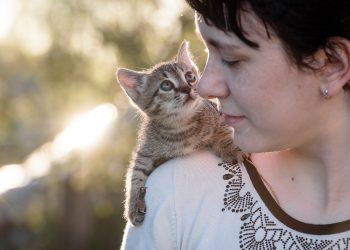Caterwauling is a distinct feline sound, one that can send first-time owners wondering what’s happening to their cats. What is the real deal with the caterwauling sound of cats? Let’s find out in today’s special report.
Caterwauling Definition: What Is Caterwauling?
Caterwauling’s meaning: Dictionaries define caterwauling as a type of shrill, wailing noise that is a cross between howling and crying. This is a tuneless type of noise, mostly discordant, and yes, the sound is meant to disturb because it is one of many ways cats express themselves through vocalization.
What is the Purpose of Caterwauling?
Cat caterwauling is largely associated with reproductive activities. Yes, you read that right. When cats are caterwauling, that means they are engaged in mating activities.
When you hear a boom and a crash and cats running wildly zooming around rooftops and lawns, that’s the ‘dance’ of toms and queens in their heat cycle. Both males and females perform caterwauling. A caterwauling tom will meet a caterwauling queen.

Both will caterwaul in unison. If you want to avoid caterwauling noises in the future, then you have to spay or neuter your cats. Will your cats caterwaul even if they are stuck inside the house? Yes, they will, especially if there are other cats around the neighborhood.
Caterwauling sounds disturbing and dramatic at the same time. Vets believe that it is the equivalent of cats saying that there is something important happening.
They are drawing attention to themselves when they caterwaul, too. In feline circles, the sound’s meaning is always clear, and other cats will understand what is taking place immediately.
While caterwauling’s primary purpose is to signal reproductive activities, there are also other instances that cats may resort to this sound to communicate with other cats and their owners. Let’s take a look at these other instances so you can better understand your cats.

- Cats are known for mostly hiding what they feel, and they aren’t the type to show clingy behavior when there is discomfort or pain involved.
However, in some situations, when the discomfort or pain has become too much, and your cat will begin to caterwaul. If the behavior continues for days, it’s safe to say that your cat needs a visit to the nearest veterinarian’s clinic.
Cats with overactive thyroid conditions and chronic kidney disease can also caterwaul because of difficulties in urinating and general pain or malaise. Excessive vocalizations are a hallmark sign that there might be a serious medical condition taking place, and your cat is suffering from it. - Yet another possible trigger of caterwauling is outdoor activities. Cats are no guard dogs, but that doesn’t mean that they are not territorial, or they don’t know how to respond to intruders. This is a very common issue or scenario with cats. You will suddenly see your cat standing on some piece of furniture, looking out the window. When you track what your cat is tracking, you will likely see a dog or cat in plain’s eye view. What is happening in your cat is territorial, and other animals are invading the turf of the owner’s turf. Your cat is as much as alerting you and threatening the invader. Unfortunately, the invader probably doesn’t care as your cat is inside. One solution to this problem is simply lowering the blinds or curtains, so your cat doesn’t caterwaul as much. We can’t guarantee that your cat will not caterwaul to all in the future, but this will likely cut down the chances of it happening more frequently.

- We don’t like changes, and cats don’t either. Despite being non-verbal, cats can vocalize when they are feeling psychological stress. All animals experience stress, and they have to process that stress. Processing stress and managing emotions allow animals to survive stressful situations. When a cat is caterwauling, there may be some psychological stress involved.
This type of caterwauling may be accompanied by some other signs like clinginess and anxiety. We all know what the clinginess looks like. Your cat will trail you around the house, meowing and crying all the time. Cats can also caterwaul when you go to work and are not secure with their surroundings. Slight changes in the environment can trigger this behavior.
And as much as we want to explain to cats that changes are alright, the fact of the matter is we can’t. Cats have to process their stress on their own.
If you have changed houses and you’re now in a new residence, your cat may show signs of stress by caterwauling. What happens is that cats will feel that they have been abandoned because the new residence is foreign and has not been claimed yet by the cats. If you think that territorial behavior is just funny because cats ‘don’t have to mark their own home,’ think again. Territorial behavior is part of the normal psychology of cats. When cats mark their home and spots in and out of the home, they are making themselves feel more secure in that area. Their brains process that they are in a safe space.
One solution to this problem is anticipating the reaction and provide reassurance. Bonding with your cat a little more frequently can help build the base of initial confidence that your cat needs to explore the new home and make it his own. We certainly don’t want your cat to feel that the new house is foreign, as this can lead to even more stress and other negative behaviors and “acting out.” - Finally, cats can caterwaul loudly to get the human master’s attention. While cats can hide their emotions and pain, they don’t always do so. At some point, they also vocalize to show that they need or want something. This type of caterwauling may be caused by various needs, like physical attention or playtime, food, etc.

Next on your reading list:











